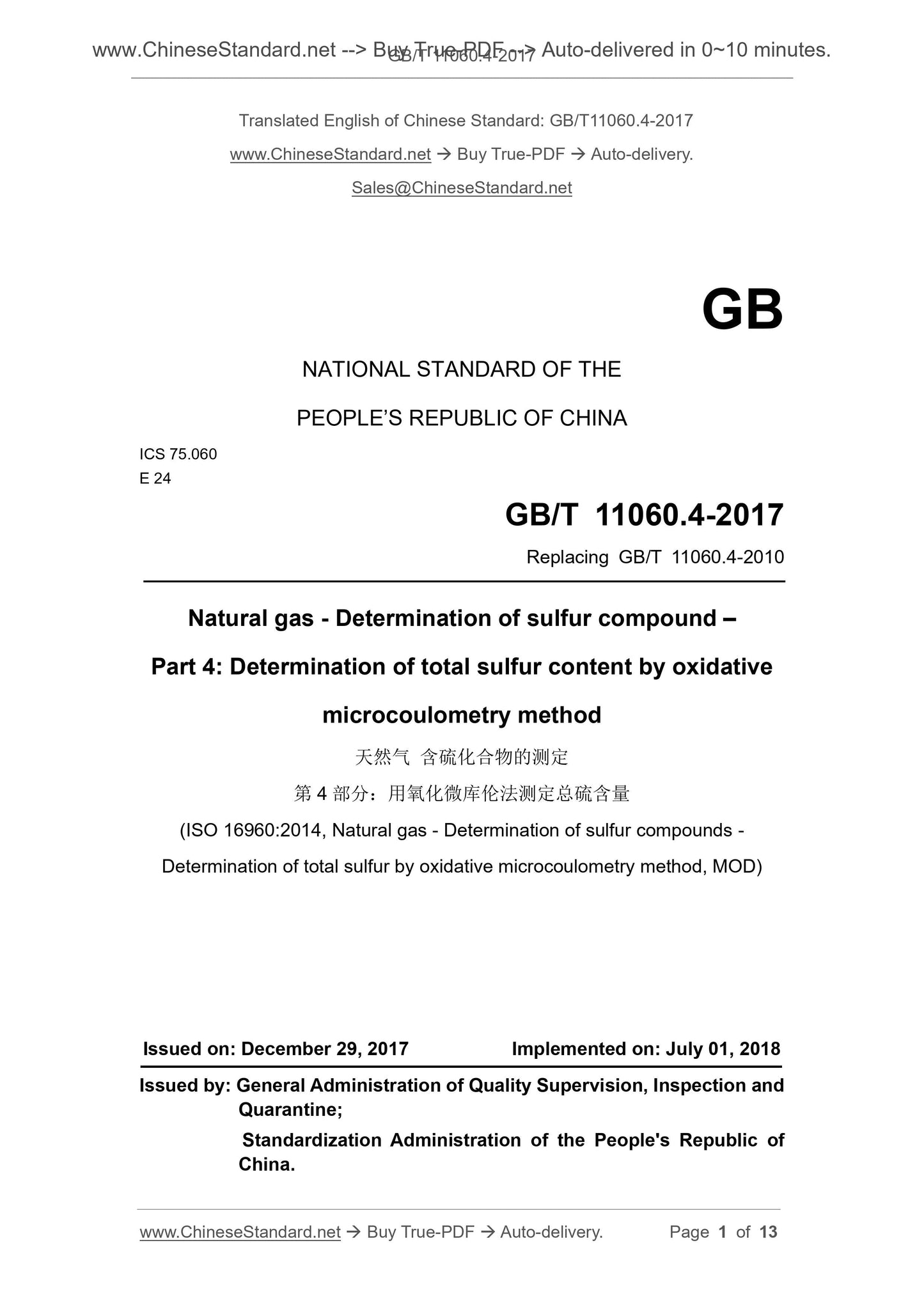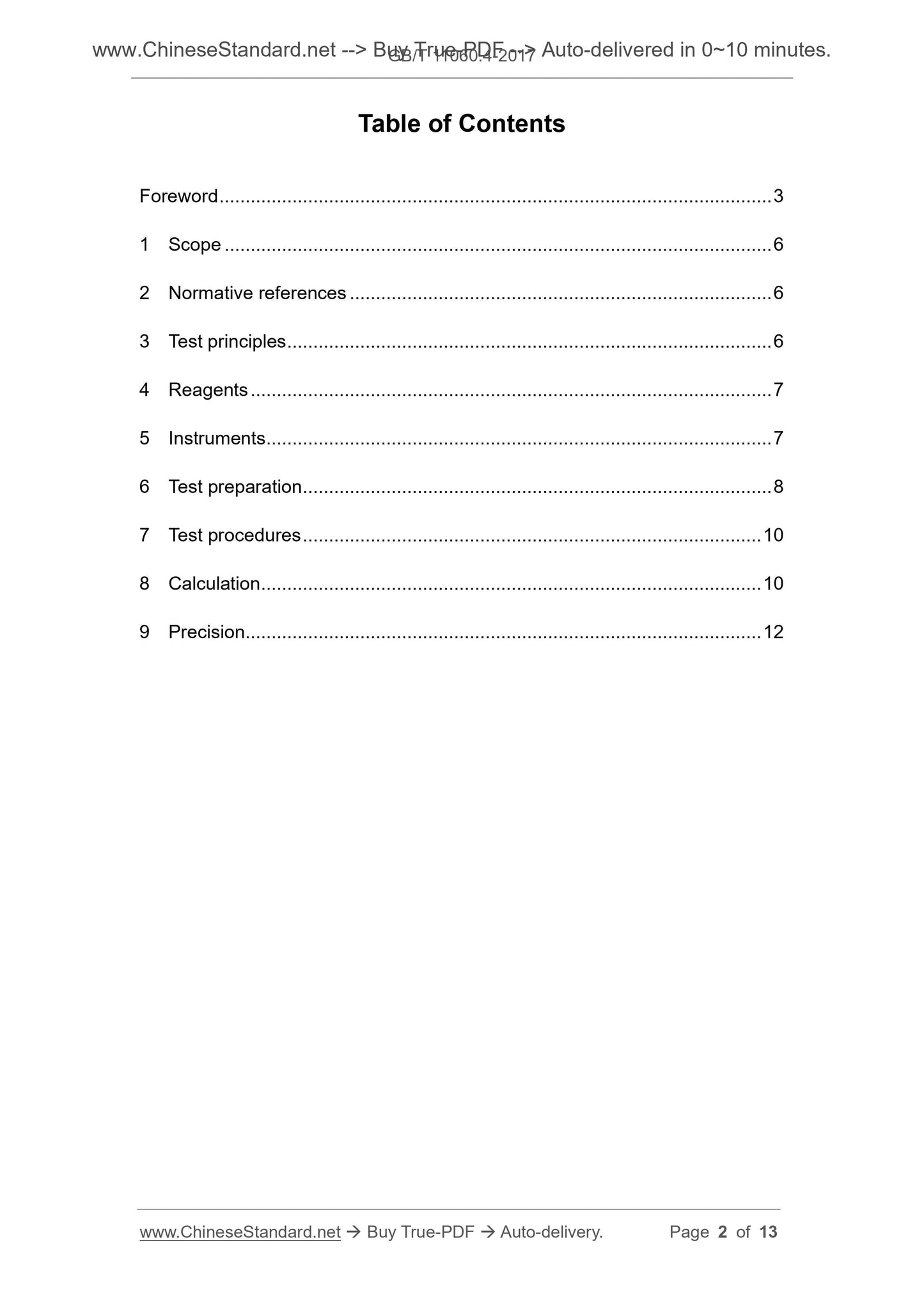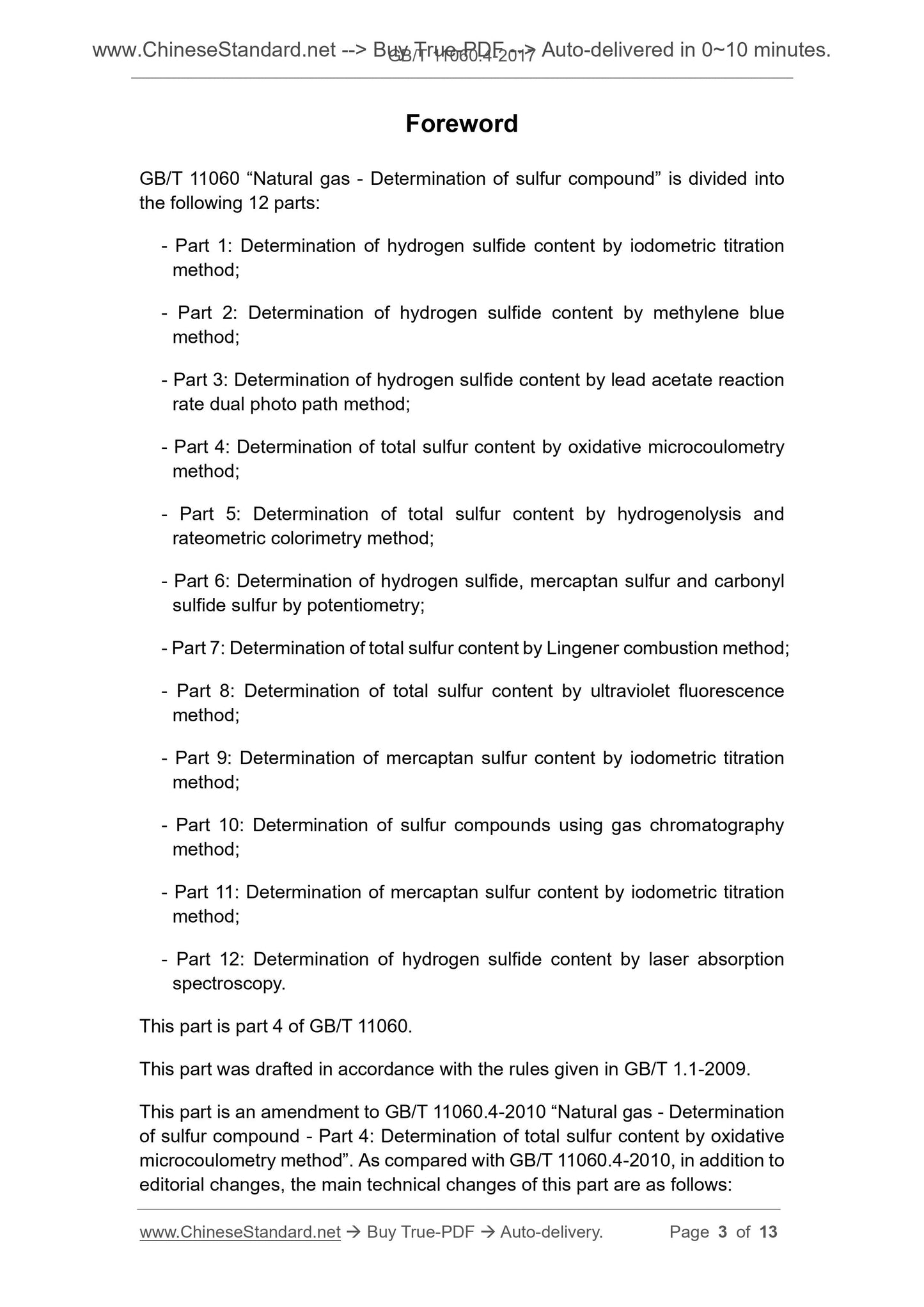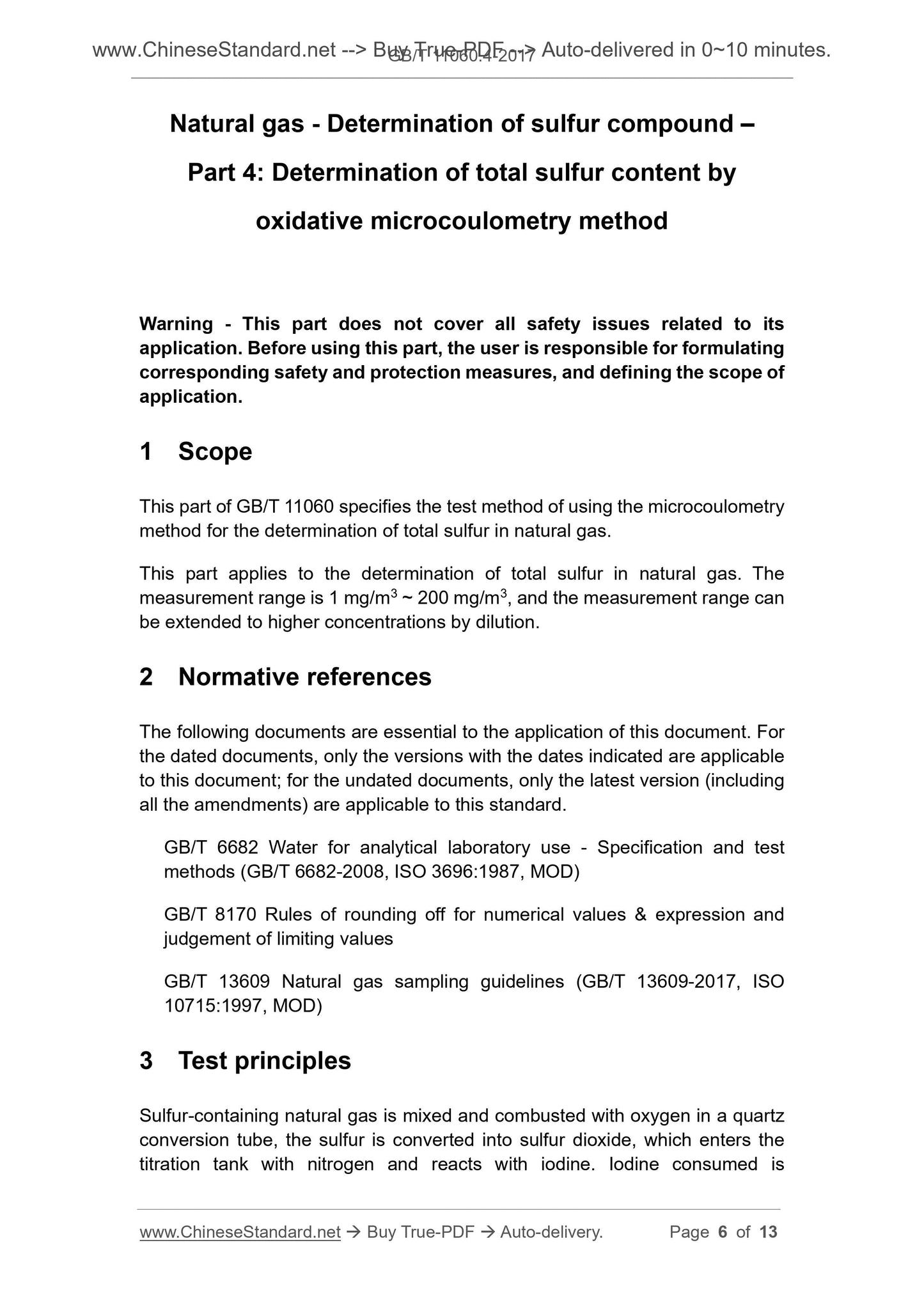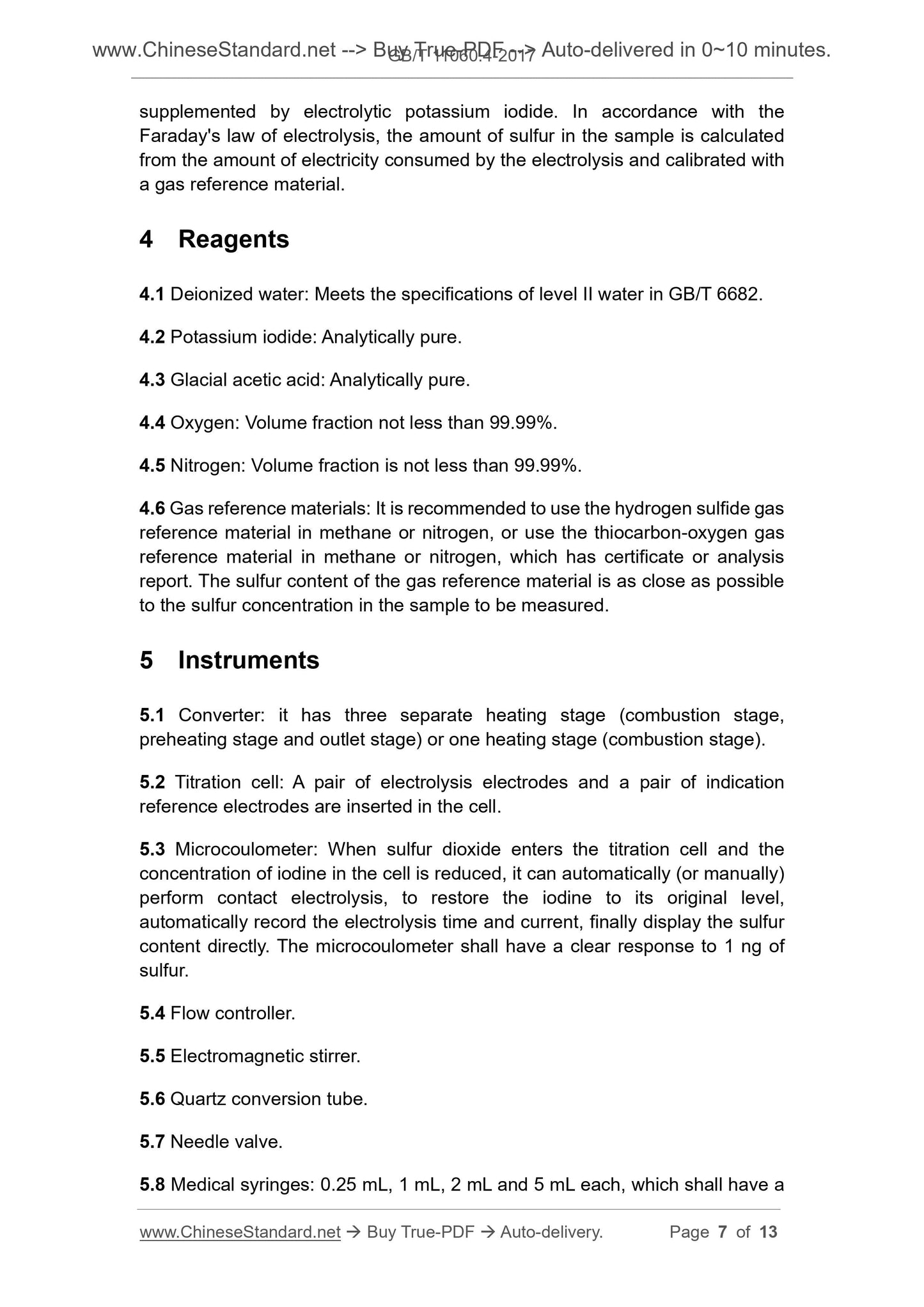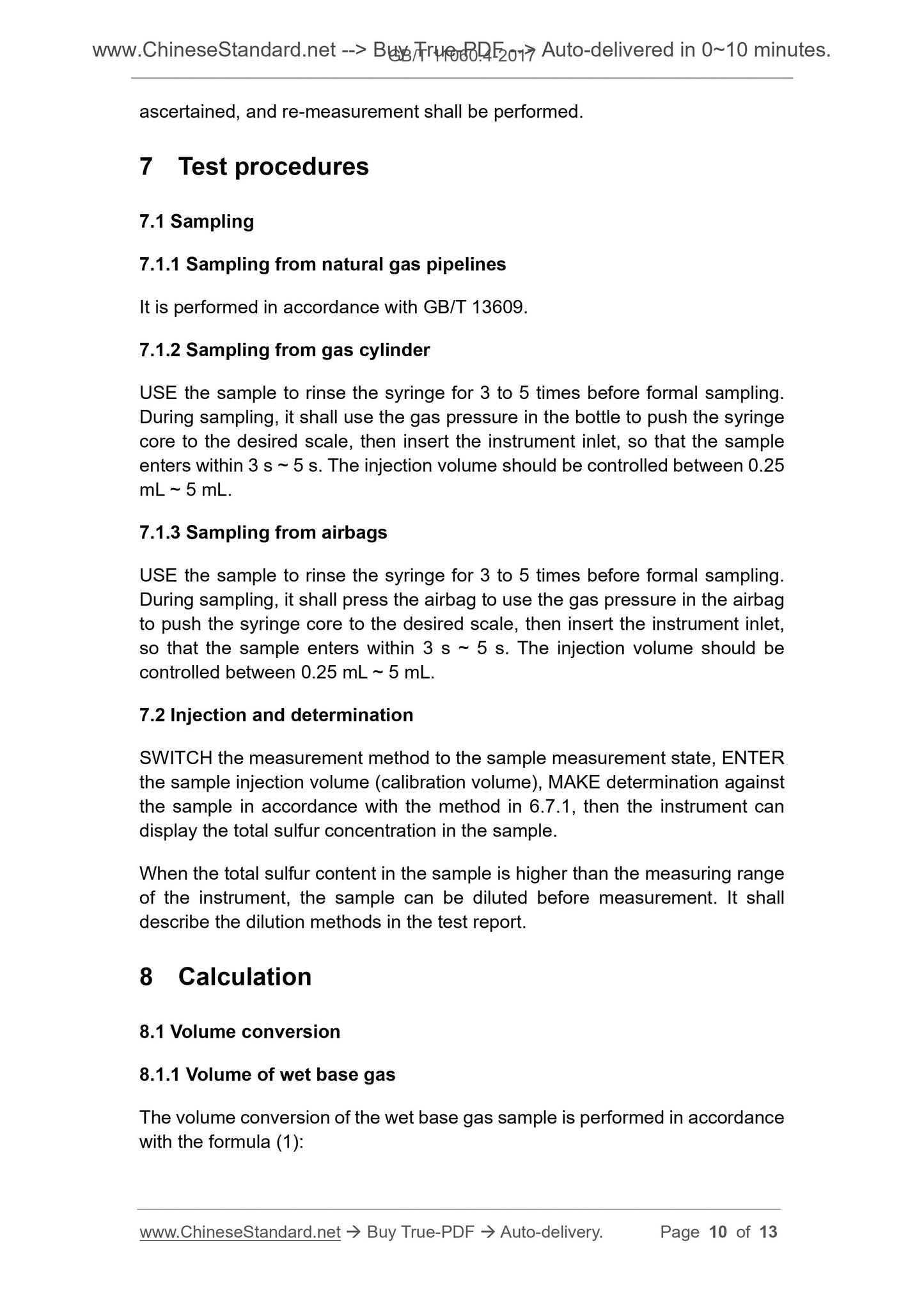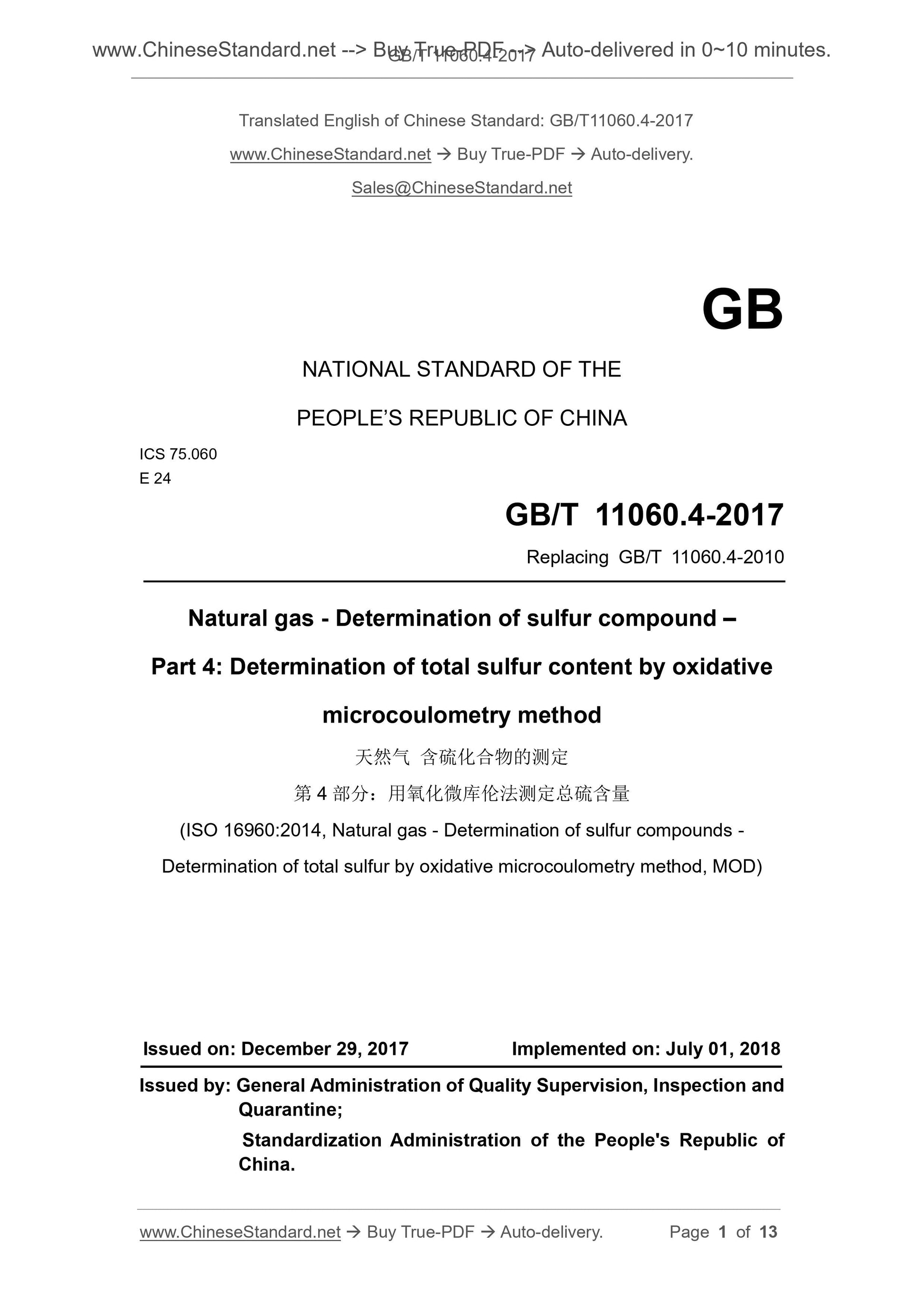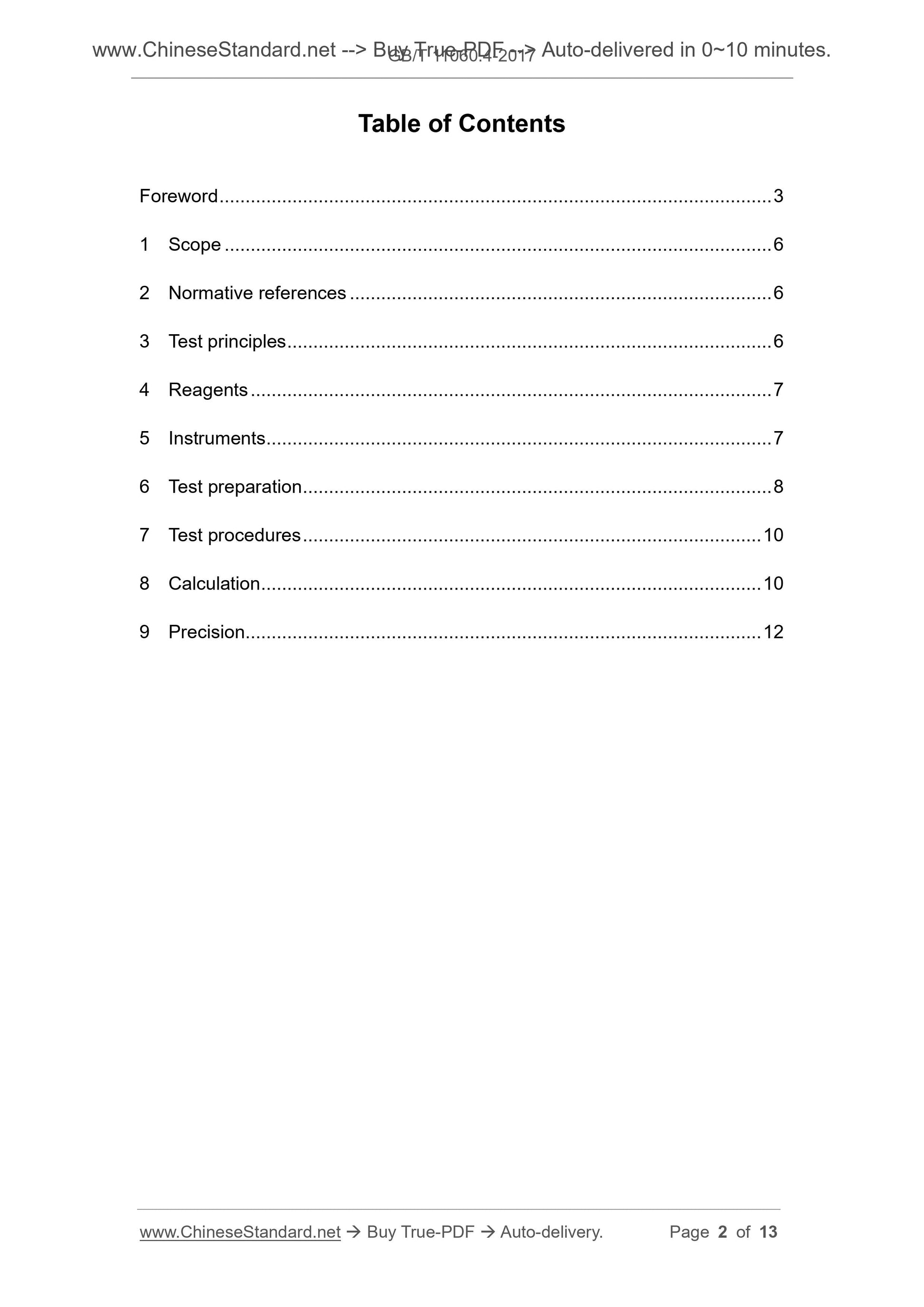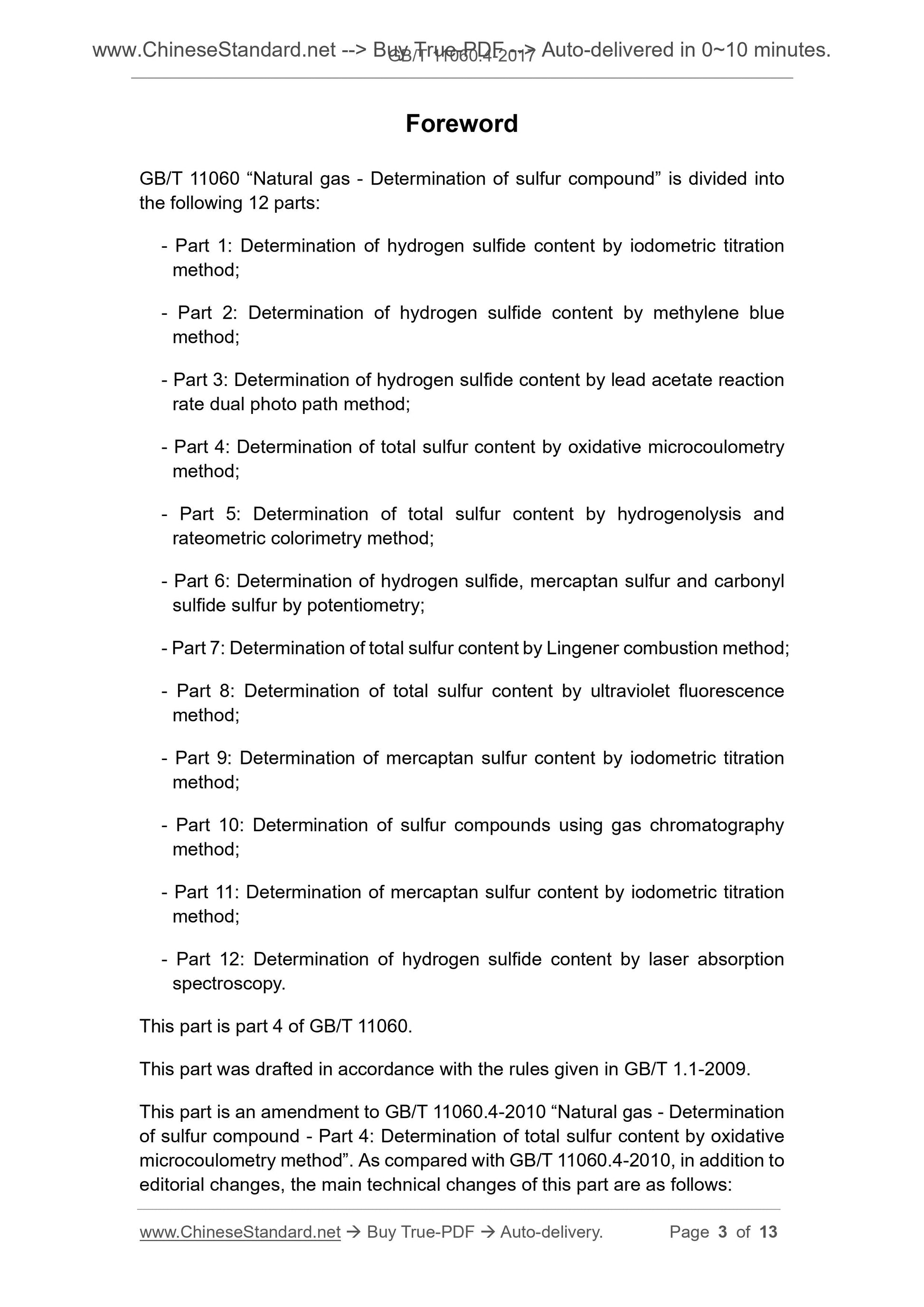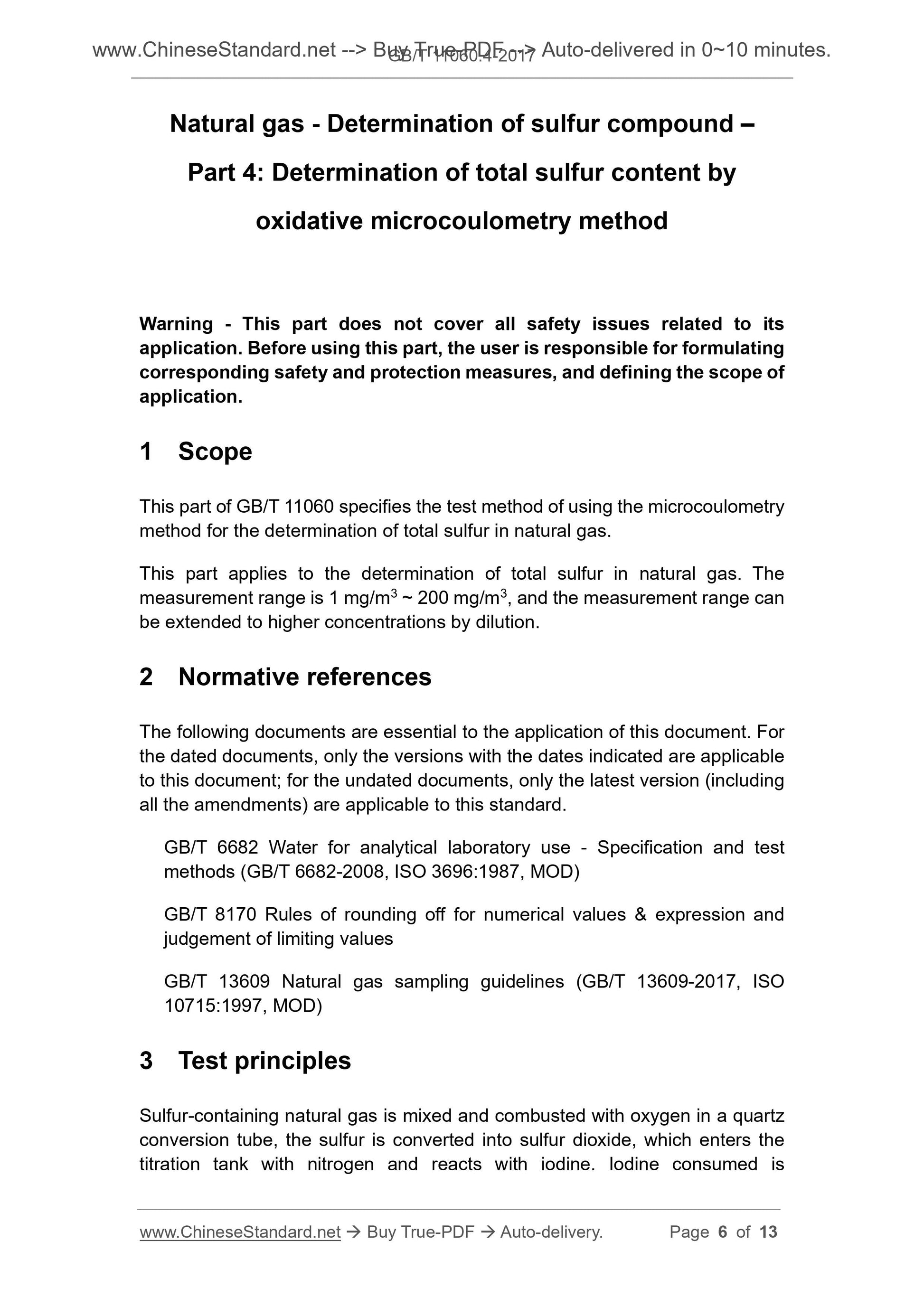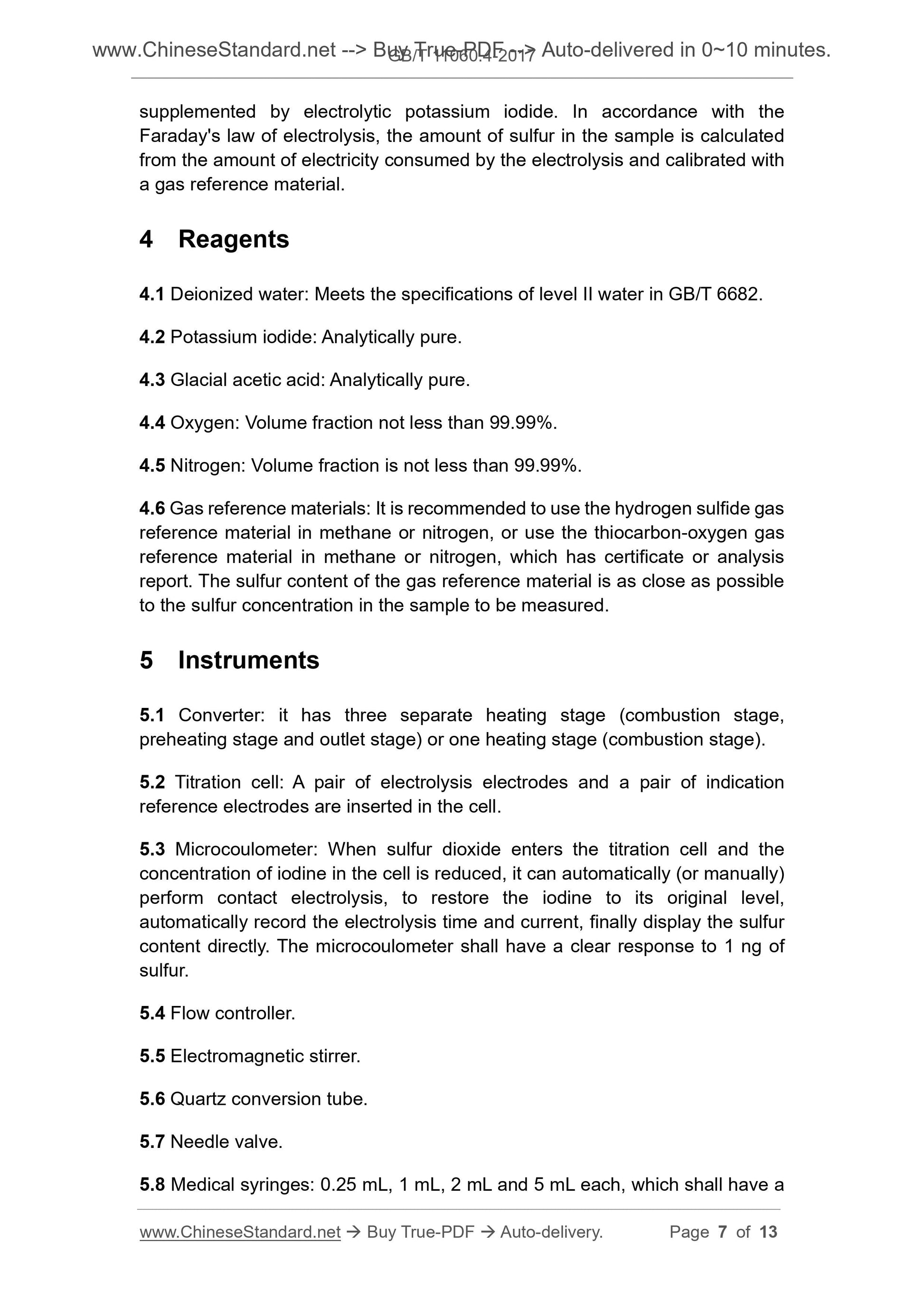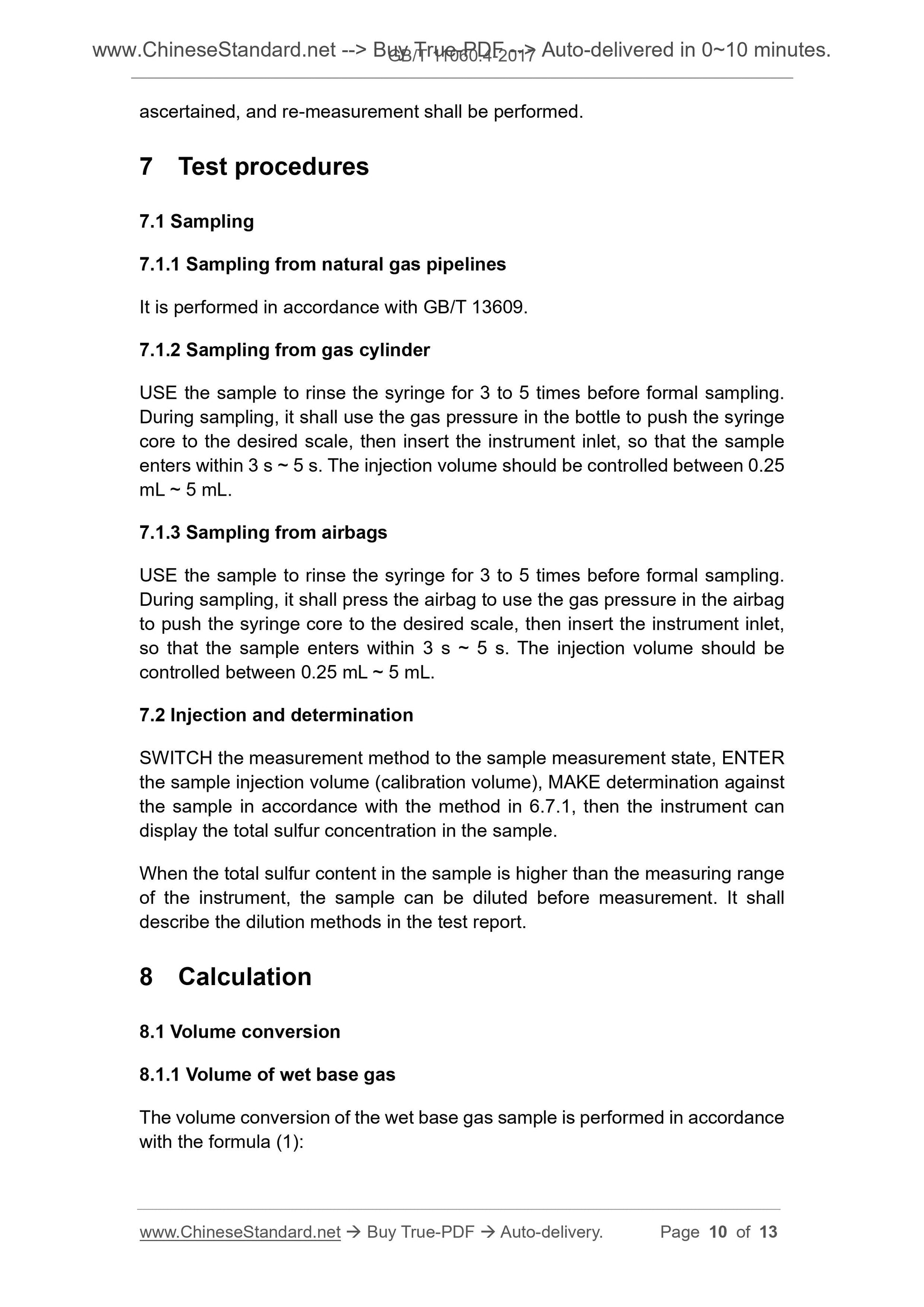1
/
of
6
www.ChineseStandard.us -- Field Test Asia Pte. Ltd.
GB/T 11060.4-2017 English PDF (GB/T11060.4-2017)
GB/T 11060.4-2017 English PDF (GB/T11060.4-2017)
Regular price
$150.00
Regular price
Sale price
$150.00
Unit price
/
per
Shipping calculated at checkout.
Couldn't load pickup availability
GB/T 11060.4-2017: Natural gas -- Determination of sulfur compound -- Part 4: Determination of total sulfur content by oxidative micro-coulometry method
Delivery: 9 seconds. Download (& Email) true-PDF + Invoice.
Get Quotation: Click GB/T 11060.4-2017 (Self-service in 1-minute)
Historical versions (Master-website): GB/T 11060.4-2017
Preview True-PDF (Reload/Scroll-down if blank)
GB/T 11060.4-2017
GB
NATIONAL STANDARD OF THE
PEOPLE’S REPUBLIC OF CHINA
ICS 75.060
E 24
Replacing GB/T 11060.4-2010
Natural gas - Determination of sulfur compound –
Part 4. Determination of total sulfur content by oxidative
microcoulometry method
(ISO 16960.2014, Natural gas - Determination of sulfur compounds -
Determination of total sulfur by oxidative microcoulometry method, MOD)
ISSUED ON. DECEMBER 29, 2017
IMPLEMENTED ON. JULY 01, 2018
Issued by. General Administration of Quality Supervision, Inspection and
Quarantine;
Standardization Administration of the People's Republic of
China.
Table of Contents
Foreword . 3
1 Scope .. 6
2 Normative references . 6
3 Test principles . 6
4 Reagents . 7
5 Instruments .. 7
6 Test preparation . 8
7 Test procedures .. 10
8 Calculation . 10
9 Precision. 12
Foreword
GB/T 11060 “Natural gas - Determination of sulfur compound” is divided into
the following 12 parts.
- Part 1. Determination of hydrogen sulfide content by iodometric titration
method;
- Part 2. Determination of hydrogen sulfide content by methylene blue
method;
- Part 3. Determination of hydrogen sulfide content by lead acetate reaction
rate dual photo path method;
- Part 4. Determination of total sulfur content by oxidative microcoulometry
method;
- Part 5. Determination of total sulfur content by hydrogenolysis and
rateometric colorimetry method;
- Part 6. Determination of hydrogen sulfide, mercaptan sulfur and carbonyl
sulfide sulfur by potentiometry;
- Part 7. Determination of total sulfur content by Lingener combustion method;
- Part 8. Determination of total sulfur content by ultraviolet fluorescence
method;
- Part 9. Determination of mercaptan sulfur content by iodometric titration
method;
- Part 10. Determination of sulfur compounds using gas chromatography
method;
- Part 11. Determination of mercaptan sulfur content by iodometric titration
method;
- Part 12. Determination of hydrogen sulfide content by laser absorption
spectroscopy.
This part is part 4 of GB/T 11060.
This part was drafted in accordance with the rules given in GB/T 1.1-2009.
This part is an amendment to GB/T 11060.4-2010 “Natural gas - Determination
of sulfur compound - Part 4. Determination of total sulfur content by oxidative
microcoulometry method”. As compared with GB/T 11060.4-2010, in addition to
editorial changes, the main technical changes of this part are as follows.
Natural gas - Determination of sulfur compound –
Part 4. Determination of total sulfur content by
oxidative microcoulometry method
Warning - This part does not cover all safety issues related to its
application. Before using this part, the user is responsible for formulating
corresponding safety and protection measures, and defining the scope of
application.
1 Scope
This part of GB/T 11060 specifies the test method of using the microcoulometry
method for the determination of total sulfur in natural gas.
This part applies to the determination of total sulfur in natural gas. The
measurement range is 1 mg/m3 ~ 200 mg/m3, and the measurement range can
be extended to higher concentrations by dilution.
2 Normative references
The following documents are essential to the application of this document. For
the dated documents, only the versions with the dates indicated are applicable
to this document; for the undated documents, only the latest version (including
all the amendments) are applicable to this standard.
GB/T 6682 Water for analytical laboratory use - Specification and test
methods (GB/T 6682-2008, ISO 3696.1987, MOD)
GB/T 8170 Rules of rounding off for numerical values and expression and
judgement of limiting values
GB/T 13609 Natural gas sampling guidelines (GB/T 13609-2017, ISO
10715.1997, MOD)
3 Test principles
Sulfur-containing natural gas is mixed and combusted with oxygen in a quartz
conversion tube, the sulfur is converted into sulfur dioxide, which enters the
titration tank with nitrogen and reacts with iodine. Iodine consumed is
supplemented by electrolytic potassium iodide. In accordance with the
Faraday's law of electrolysis, the amount of sulfur in the sample is calculated
from the amount of electricity consumed by the electrolysis and calibrated with
a gas reference material.
4 Reagents
4.1 Deionized water. Meets the specifications of level II water in GB/T 6682.
4.2 Potassium iodide. Analytically pure.
4.3 Glacial acetic acid. Analytically pure.
4.4 Oxygen. Volume fraction not less than 99.99%.
4.5 Nitrogen. Volume fraction is not less than 99.99%.
4.6 Gas reference materials. It is recommended to use the hydrogen sulfide gas
reference material in methane or nitrogen, or use the thiocarbon-oxygen gas
reference material in methane or nitrogen, which has certificate or analysis
report. The sulfur content of the gas reference material is as close as possible
to the sulfur concentration in the sample to be measured.
5 Instruments
5.1 Converter. it has three separate heating stage (combustion stage,
preheating stage and outlet stage) or one heating stage (combustion stage).
5.2 Titration cell. A pair of electrolysis electrodes and a pair of indication
reference electrodes are inserted in the cell.
5.3 Microcoulometer. When sulfur dioxide enters the titration cell and the
concentration of iodine in the cell is reduced, it can automatically (or manually)
perform contact electrolysis, to restore the iodine to its original level,
automatically record the electrolysis time and current, finally display the sulfur
content directly. The microcoulometer shall have a clear response to 1 ng of
sulfur.
5.4 Flow controller.
5.5 Electromagnetic stirrer.
5.6 Quartz conversion tube.
5.7 Needle valve.
5.8 Medical syringes. 0.25 mL, 1 mL, 2 mL and 5 mL each, which shall have a
ascertained, and re-measurement shall be performed.
7 Test procedures
7.1 Sampling
7.1.1 Sampling from natural gas pipelines
It is performed in accordance with GB/T 13609.
7.1.2 Sampling from gas cylinder
USE the sample to rinse the syringe for 3 to 5 times before formal sampling.
During sampling, it shall use the gas pressure in the bottle to push the syringe
core to the desired scale, then insert the instrument inlet, so that the sample
enters within 3 s ~ 5 s. The injection volume should be controlled between 0.25
mL ~ 5 mL.
7.1.3 Sampling from airbags
USE the sample to rinse the syringe for 3 to 5 times before formal sampling.
During sampling, it shall press the airbag to use the gas pressure in the airbag
to push the syringe core to the desired scale, then insert the instrument inlet,
so that the sample enters within 3 s ~ 5 s. The injection volume should be
controlled between 0.25 mL ~ 5 mL.
7.2 Injection and determination
SWITCH the measurement method to the sample measurement state, ENTER
the sample injection volume (calibration volume), MAKE determination against
the sample in accordance with the method in 6.7.1, then the instrument can
display the total sulfur concentration in the sample.
When the total sulfur content in the sample is higher than the measuring range
of the instrument, the sample can be diluted before measurement. It shall
describe the dilution methods in the test report.
8 Calculation
8.1 Volume conversion
8.1.1 Volume of wet base gas
The volume conversion of the wet base gas sample is performed in accordance
with the formula (1).
GB/T 11060.4-2017
GB
NATIONAL STANDARD OF THE
PEOPLE’S REPUBLIC OF CHINA
ICS 75.060
E 24
Replacing GB/T 11060.4-2010
Natural gas - Determination of sulfur compound –
Part 4. Determination of total sulfur content by oxidative
microcoulometry method
(ISO 16960.2014, Natural gas - Determination of sulfur compounds -
Determination of total sulfur by oxidative microcoulometry method, MOD)
ISSUED ON. DECEMBER 29, 2017
IMPLEMENTED ON. JULY 01, 2018
Issued by. General Administration of Quality Supervision, Inspection and
Quarantine;
Standardization Administration of the People's Republic of
China.
Table of Contents
Foreword . 3
1 Scope .. 6
2 Normative references . 6
3 Test principles . 6
4 Reagents . 7
5 Instruments .. 7
6 Test preparation . 8
7 Test procedures .. 10
8 Calculation . 10
9 Precision. 12
Foreword
GB/T 11060 “Natural gas - Determination of sulfur compound” is divided into
the following 12 parts.
- Part 1. Determination of hydrogen sulfide content by iodometric titration
method;
- Part 2. Determination of hydrogen sulfide content by methylene blue
method;
- Part 3. Determination of hydrogen sulfide content by lead acetate reaction
rate dual photo path method;
- Part 4. Determination of total sulfur content by oxidative microcoulometry
method;
- Part 5. Determination of total sulfur content by hydrogenolysis and
rateometric colorimetry method;
- Part 6. Determination of hydrogen sulfide, mercaptan sulfur and carbonyl
sulfide sulfur by potentiometry;
- Part 7. Determination of total sulfur content by Lingener combustion method;
- Part 8. Determination of total sulfur content by ultraviolet fluorescence
method;
- Part 9. Determination of mercaptan sulfur content by iodometric titration
method;
- Part 10. Determination of sulfur compounds using gas chromatography
method;
- Part 11. Determination of mercaptan sulfur content by iodometric titration
method;
- Part 12. Determination of hydrogen sulfide content by laser absorption
spectroscopy.
This part is part 4 of GB/T 11060.
This part was drafted in accordance with the rules given in GB/T 1.1-2009.
This part is an amendment to GB/T 11060.4-2010 “Natural gas - Determination
of sulfur compound - Part 4. Determination of total sulfur content by oxidative
microcoulometry method”. As compared with GB/T 11060.4-2010, in addition to
editorial changes, the main technical changes of this part are as follows.
Natural gas - Determination of sulfur compound –
Part 4. Determination of total sulfur content by
oxidative microcoulometry method
Warning - This part does not cover all safety issues related to its
application. Before using this part, the user is responsible for formulating
corresponding safety and protection measures, and defining the scope of
application.
1 Scope
This part of GB/T 11060 specifies the test method of using the microcoulometry
method for the determination of total sulfur in natural gas.
This part applies to the determination of total sulfur in natural gas. The
measurement range is 1 mg/m3 ~ 200 mg/m3, and the measurement range can
be extended to higher concentrations by dilution.
2 Normative references
The following documents are essential to the application of this document. For
the dated documents, only the versions with the dates indicated are applicable
to this document; for the undated documents, only the latest version (including
all the amendments) are applicable to this standard.
GB/T 6682 Water for analytical laboratory use - Specification and test
methods (GB/T 6682-2008, ISO 3696.1987, MOD)
GB/T 8170 Rules of rounding off for numerical values and expression and
judgement of limiting values
GB/T 13609 Natural gas sampling guidelines (GB/T 13609-2017, ISO
10715.1997, MOD)
3 Test principles
Sulfur-containing natural gas is mixed and combusted with oxygen in a quartz
conversion tube, the sulfur is converted into sulfur dioxide, which enters the
titration tank with nitrogen and reacts with iodine. Iodine consumed is
supplemented by electrolytic potassium iodide. In accordance with the
Faraday's law of electrolysis, the amount of sulfur in the sample is calculated
from the amount of electricity consumed by the electrolysis and calibrated with
a gas reference material.
4 Reagents
4.1 Deionized water. Meets the specifications of level II water in GB/T 6682.
4.2 Potassium iodide. Analytically pure.
4.3 Glacial acetic acid. Analytically pure.
4.4 Oxygen. Volume fraction not less than 99.99%.
4.5 Nitrogen. Volume fraction is not less than 99.99%.
4.6 Gas reference materials. It is recommended to use the hydrogen sulfide gas
reference material in methane or nitrogen, or use the thiocarbon-oxygen gas
reference material in methane or nitrogen, which has certificate or analysis
report. The sulfur content of the gas reference material is as close as possible
to the sulfur concentration in the sample to be measured.
5 Instruments
5.1 Converter. it has three separate heating stage (combustion stage,
preheating stage and outlet stage) or one heating stage (combustion stage).
5.2 Titration cell. A pair of electrolysis electrodes and a pair of indication
reference electrodes are inserted in the cell.
5.3 Microcoulometer. When sulfur dioxide enters the titration cell and the
concentration of iodine in the cell is reduced, it can automatically (or manually)
perform contact electrolysis, to restore the iodine to its original level,
automatically record the electrolysis time and current, finally display the sulfur
content directly. The microcoulometer shall have a clear response to 1 ng of
sulfur.
5.4 Flow controller.
5.5 Electromagnetic stirrer.
5.6 Quartz conversion tube.
5.7 Needle valve.
5.8 Medical syringes. 0.25 mL, 1 mL, 2 mL and 5 mL each, which shall have a
ascertained, and re-measurement shall be performed.
7 Test procedures
7.1 Sampling
7.1.1 Sampling from natural gas pipelines
It is performed in accordance with GB/T 13609.
7.1.2 Sampling from gas cylinder
USE the sample to rinse the syringe for 3 to 5 times before formal sampling.
During sampling, it shall use the gas pressure in the bottle to push the syringe
core to the desired scale, then insert the instrument inlet, so that the sample
enters within 3 s ~ 5 s. The injection volume should be controlled between 0.25
mL ~ 5 mL.
7.1.3 Sampling fr...
Delivery: 9 seconds. Download (& Email) true-PDF + Invoice.
Get Quotation: Click GB/T 11060.4-2017 (Self-service in 1-minute)
Historical versions (Master-website): GB/T 11060.4-2017
Preview True-PDF (Reload/Scroll-down if blank)
GB/T 11060.4-2017
GB
NATIONAL STANDARD OF THE
PEOPLE’S REPUBLIC OF CHINA
ICS 75.060
E 24
Replacing GB/T 11060.4-2010
Natural gas - Determination of sulfur compound –
Part 4. Determination of total sulfur content by oxidative
microcoulometry method
(ISO 16960.2014, Natural gas - Determination of sulfur compounds -
Determination of total sulfur by oxidative microcoulometry method, MOD)
ISSUED ON. DECEMBER 29, 2017
IMPLEMENTED ON. JULY 01, 2018
Issued by. General Administration of Quality Supervision, Inspection and
Quarantine;
Standardization Administration of the People's Republic of
China.
Table of Contents
Foreword . 3
1 Scope .. 6
2 Normative references . 6
3 Test principles . 6
4 Reagents . 7
5 Instruments .. 7
6 Test preparation . 8
7 Test procedures .. 10
8 Calculation . 10
9 Precision. 12
Foreword
GB/T 11060 “Natural gas - Determination of sulfur compound” is divided into
the following 12 parts.
- Part 1. Determination of hydrogen sulfide content by iodometric titration
method;
- Part 2. Determination of hydrogen sulfide content by methylene blue
method;
- Part 3. Determination of hydrogen sulfide content by lead acetate reaction
rate dual photo path method;
- Part 4. Determination of total sulfur content by oxidative microcoulometry
method;
- Part 5. Determination of total sulfur content by hydrogenolysis and
rateometric colorimetry method;
- Part 6. Determination of hydrogen sulfide, mercaptan sulfur and carbonyl
sulfide sulfur by potentiometry;
- Part 7. Determination of total sulfur content by Lingener combustion method;
- Part 8. Determination of total sulfur content by ultraviolet fluorescence
method;
- Part 9. Determination of mercaptan sulfur content by iodometric titration
method;
- Part 10. Determination of sulfur compounds using gas chromatography
method;
- Part 11. Determination of mercaptan sulfur content by iodometric titration
method;
- Part 12. Determination of hydrogen sulfide content by laser absorption
spectroscopy.
This part is part 4 of GB/T 11060.
This part was drafted in accordance with the rules given in GB/T 1.1-2009.
This part is an amendment to GB/T 11060.4-2010 “Natural gas - Determination
of sulfur compound - Part 4. Determination of total sulfur content by oxidative
microcoulometry method”. As compared with GB/T 11060.4-2010, in addition to
editorial changes, the main technical changes of this part are as follows.
Natural gas - Determination of sulfur compound –
Part 4. Determination of total sulfur content by
oxidative microcoulometry method
Warning - This part does not cover all safety issues related to its
application. Before using this part, the user is responsible for formulating
corresponding safety and protection measures, and defining the scope of
application.
1 Scope
This part of GB/T 11060 specifies the test method of using the microcoulometry
method for the determination of total sulfur in natural gas.
This part applies to the determination of total sulfur in natural gas. The
measurement range is 1 mg/m3 ~ 200 mg/m3, and the measurement range can
be extended to higher concentrations by dilution.
2 Normative references
The following documents are essential to the application of this document. For
the dated documents, only the versions with the dates indicated are applicable
to this document; for the undated documents, only the latest version (including
all the amendments) are applicable to this standard.
GB/T 6682 Water for analytical laboratory use - Specification and test
methods (GB/T 6682-2008, ISO 3696.1987, MOD)
GB/T 8170 Rules of rounding off for numerical values and expression and
judgement of limiting values
GB/T 13609 Natural gas sampling guidelines (GB/T 13609-2017, ISO
10715.1997, MOD)
3 Test principles
Sulfur-containing natural gas is mixed and combusted with oxygen in a quartz
conversion tube, the sulfur is converted into sulfur dioxide, which enters the
titration tank with nitrogen and reacts with iodine. Iodine consumed is
supplemented by electrolytic potassium iodide. In accordance with the
Faraday's law of electrolysis, the amount of sulfur in the sample is calculated
from the amount of electricity consumed by the electrolysis and calibrated with
a gas reference material.
4 Reagents
4.1 Deionized water. Meets the specifications of level II water in GB/T 6682.
4.2 Potassium iodide. Analytically pure.
4.3 Glacial acetic acid. Analytically pure.
4.4 Oxygen. Volume fraction not less than 99.99%.
4.5 Nitrogen. Volume fraction is not less than 99.99%.
4.6 Gas reference materials. It is recommended to use the hydrogen sulfide gas
reference material in methane or nitrogen, or use the thiocarbon-oxygen gas
reference material in methane or nitrogen, which has certificate or analysis
report. The sulfur content of the gas reference material is as close as possible
to the sulfur concentration in the sample to be measured.
5 Instruments
5.1 Converter. it has three separate heating stage (combustion stage,
preheating stage and outlet stage) or one heating stage (combustion stage).
5.2 Titration cell. A pair of electrolysis electrodes and a pair of indication
reference electrodes are inserted in the cell.
5.3 Microcoulometer. When sulfur dioxide enters the titration cell and the
concentration of iodine in the cell is reduced, it can automatically (or manually)
perform contact electrolysis, to restore the iodine to its original level,
automatically record the electrolysis time and current, finally display the sulfur
content directly. The microcoulometer shall have a clear response to 1 ng of
sulfur.
5.4 Flow controller.
5.5 Electromagnetic stirrer.
5.6 Quartz conversion tube.
5.7 Needle valve.
5.8 Medical syringes. 0.25 mL, 1 mL, 2 mL and 5 mL each, which shall have a
ascertained, and re-measurement shall be performed.
7 Test procedures
7.1 Sampling
7.1.1 Sampling from natural gas pipelines
It is performed in accordance with GB/T 13609.
7.1.2 Sampling from gas cylinder
USE the sample to rinse the syringe for 3 to 5 times before formal sampling.
During sampling, it shall use the gas pressure in the bottle to push the syringe
core to the desired scale, then insert the instrument inlet, so that the sample
enters within 3 s ~ 5 s. The injection volume should be controlled between 0.25
mL ~ 5 mL.
7.1.3 Sampling from airbags
USE the sample to rinse the syringe for 3 to 5 times before formal sampling.
During sampling, it shall press the airbag to use the gas pressure in the airbag
to push the syringe core to the desired scale, then insert the instrument inlet,
so that the sample enters within 3 s ~ 5 s. The injection volume should be
controlled between 0.25 mL ~ 5 mL.
7.2 Injection and determination
SWITCH the measurement method to the sample measurement state, ENTER
the sample injection volume (calibration volume), MAKE determination against
the sample in accordance with the method in 6.7.1, then the instrument can
display the total sulfur concentration in the sample.
When the total sulfur content in the sample is higher than the measuring range
of the instrument, the sample can be diluted before measurement. It shall
describe the dilution methods in the test report.
8 Calculation
8.1 Volume conversion
8.1.1 Volume of wet base gas
The volume conversion of the wet base gas sample is performed in accordance
with the formula (1).
GB/T 11060.4-2017
GB
NATIONAL STANDARD OF THE
PEOPLE’S REPUBLIC OF CHINA
ICS 75.060
E 24
Replacing GB/T 11060.4-2010
Natural gas - Determination of sulfur compound –
Part 4. Determination of total sulfur content by oxidative
microcoulometry method
(ISO 16960.2014, Natural gas - Determination of sulfur compounds -
Determination of total sulfur by oxidative microcoulometry method, MOD)
ISSUED ON. DECEMBER 29, 2017
IMPLEMENTED ON. JULY 01, 2018
Issued by. General Administration of Quality Supervision, Inspection and
Quarantine;
Standardization Administration of the People's Republic of
China.
Table of Contents
Foreword . 3
1 Scope .. 6
2 Normative references . 6
3 Test principles . 6
4 Reagents . 7
5 Instruments .. 7
6 Test preparation . 8
7 Test procedures .. 10
8 Calculation . 10
9 Precision. 12
Foreword
GB/T 11060 “Natural gas - Determination of sulfur compound” is divided into
the following 12 parts.
- Part 1. Determination of hydrogen sulfide content by iodometric titration
method;
- Part 2. Determination of hydrogen sulfide content by methylene blue
method;
- Part 3. Determination of hydrogen sulfide content by lead acetate reaction
rate dual photo path method;
- Part 4. Determination of total sulfur content by oxidative microcoulometry
method;
- Part 5. Determination of total sulfur content by hydrogenolysis and
rateometric colorimetry method;
- Part 6. Determination of hydrogen sulfide, mercaptan sulfur and carbonyl
sulfide sulfur by potentiometry;
- Part 7. Determination of total sulfur content by Lingener combustion method;
- Part 8. Determination of total sulfur content by ultraviolet fluorescence
method;
- Part 9. Determination of mercaptan sulfur content by iodometric titration
method;
- Part 10. Determination of sulfur compounds using gas chromatography
method;
- Part 11. Determination of mercaptan sulfur content by iodometric titration
method;
- Part 12. Determination of hydrogen sulfide content by laser absorption
spectroscopy.
This part is part 4 of GB/T 11060.
This part was drafted in accordance with the rules given in GB/T 1.1-2009.
This part is an amendment to GB/T 11060.4-2010 “Natural gas - Determination
of sulfur compound - Part 4. Determination of total sulfur content by oxidative
microcoulometry method”. As compared with GB/T 11060.4-2010, in addition to
editorial changes, the main technical changes of this part are as follows.
Natural gas - Determination of sulfur compound –
Part 4. Determination of total sulfur content by
oxidative microcoulometry method
Warning - This part does not cover all safety issues related to its
application. Before using this part, the user is responsible for formulating
corresponding safety and protection measures, and defining the scope of
application.
1 Scope
This part of GB/T 11060 specifies the test method of using the microcoulometry
method for the determination of total sulfur in natural gas.
This part applies to the determination of total sulfur in natural gas. The
measurement range is 1 mg/m3 ~ 200 mg/m3, and the measurement range can
be extended to higher concentrations by dilution.
2 Normative references
The following documents are essential to the application of this document. For
the dated documents, only the versions with the dates indicated are applicable
to this document; for the undated documents, only the latest version (including
all the amendments) are applicable to this standard.
GB/T 6682 Water for analytical laboratory use - Specification and test
methods (GB/T 6682-2008, ISO 3696.1987, MOD)
GB/T 8170 Rules of rounding off for numerical values and expression and
judgement of limiting values
GB/T 13609 Natural gas sampling guidelines (GB/T 13609-2017, ISO
10715.1997, MOD)
3 Test principles
Sulfur-containing natural gas is mixed and combusted with oxygen in a quartz
conversion tube, the sulfur is converted into sulfur dioxide, which enters the
titration tank with nitrogen and reacts with iodine. Iodine consumed is
supplemented by electrolytic potassium iodide. In accordance with the
Faraday's law of electrolysis, the amount of sulfur in the sample is calculated
from the amount of electricity consumed by the electrolysis and calibrated with
a gas reference material.
4 Reagents
4.1 Deionized water. Meets the specifications of level II water in GB/T 6682.
4.2 Potassium iodide. Analytically pure.
4.3 Glacial acetic acid. Analytically pure.
4.4 Oxygen. Volume fraction not less than 99.99%.
4.5 Nitrogen. Volume fraction is not less than 99.99%.
4.6 Gas reference materials. It is recommended to use the hydrogen sulfide gas
reference material in methane or nitrogen, or use the thiocarbon-oxygen gas
reference material in methane or nitrogen, which has certificate or analysis
report. The sulfur content of the gas reference material is as close as possible
to the sulfur concentration in the sample to be measured.
5 Instruments
5.1 Converter. it has three separate heating stage (combustion stage,
preheating stage and outlet stage) or one heating stage (combustion stage).
5.2 Titration cell. A pair of electrolysis electrodes and a pair of indication
reference electrodes are inserted in the cell.
5.3 Microcoulometer. When sulfur dioxide enters the titration cell and the
concentration of iodine in the cell is reduced, it can automatically (or manually)
perform contact electrolysis, to restore the iodine to its original level,
automatically record the electrolysis time and current, finally display the sulfur
content directly. The microcoulometer shall have a clear response to 1 ng of
sulfur.
5.4 Flow controller.
5.5 Electromagnetic stirrer.
5.6 Quartz conversion tube.
5.7 Needle valve.
5.8 Medical syringes. 0.25 mL, 1 mL, 2 mL and 5 mL each, which shall have a
ascertained, and re-measurement shall be performed.
7 Test procedures
7.1 Sampling
7.1.1 Sampling from natural gas pipelines
It is performed in accordance with GB/T 13609.
7.1.2 Sampling from gas cylinder
USE the sample to rinse the syringe for 3 to 5 times before formal sampling.
During sampling, it shall use the gas pressure in the bottle to push the syringe
core to the desired scale, then insert the instrument inlet, so that the sample
enters within 3 s ~ 5 s. The injection volume should be controlled between 0.25
mL ~ 5 mL.
7.1.3 Sampling fr...
Share
